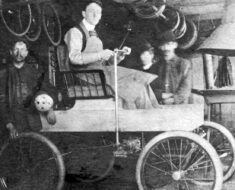Motor vehicle accidents are the leading cause of accidental deaths. Anyone who drives a car or other vehicle is exposing himself or herself to unavoidable dangers, but it is important to realize that many accidents can be prevented by taking simple safety precautions.
When choosing a car, consider carefully the number of safety factors incorporated into the car’s design. Safety regulations now demand that cars be designed in accordance with certain specifications, but above these minimum legal requirements there are wide variations in design.
If you already own a car, there are a number of items of equipment that can improve its safety and for which you, as the owner or driver, are responsible. They are not just attractive accessories; they might actually save your life. The National Safety Council calculated that if safety belts were worn at all times by all car drivers and passengers, at least 12,000 to 15,000 lives would be saved each year.
Of course, it is important not just to equip your car with these accessories but to use them every time you drive. You should wear your safety belt for every journey, no matter how short. Every time you travel with young children, make sure that they are placed securely in their child seats or harnesses in the center of the back seat. This not only protects children in the event of an accident, but also prevents them from distracting the driver. Child restraints are also required by law in all states of the United States. Make sure that the doors are locked. If there is a dog or other animal in the car, it should travel behind a grid in the back of the car.
You should carry a first-aid kit, a fire extinguisher, and a reflective warning device in your car. The warning device can be placed on the road and used as a warning sign in the event of an accident or a breakdown. Also carry a tool box, a tire gauge, and a jack designed for your car.
Your mirrors should be aligned to allow the best possible vision of the traffic behind you. A simple wide driving mirror is safer than a convex mirror, which distorts distances and thereby makes judgment of speeds more difficult. You should have your car regularly serviced, and you yourself should be able to check the condition of the tires, shock absorbers, oil, brakes, windshield wipers, and lights. By caring for the running condition of your car, you minimize the dangers of accident or breakdown.
Emergencies
A responsible driver is aware that at any time he or she may be expected to deal with emergencies. The lives of passengers and others may depend on the driver’s knowledge and skill, and the driver should take all possible precautions to minimize the risks of accident or breakdown.
Planning Ahead
Before starting any journey the driver should ensure that his or her car is in good condition. Check the engine oil level, the tire pressures (including the spare tire), the brakes, the headlights, the water level in the cooling system, the battery, and the gasoline. Take a plastic bottle or can in which to carry an emergency supply of water in case you run out. Check the car’s equipment; make sure that the jack and the tool box are in the car and that all movable objects in the trunk are secure.
For longer journeys, work out your intended route carefully before setting out, and take maps with you. If possible, find out the weather forecasts for the areas through which you intend to travel. Tell a reliable person details of the route to be taken and your estimated time of arrival.
Check the supplies in your first-aid box, which should be carried in the car at all times. For long journeys, you should also take emergency supplies of energy-giving food. Chocolate, nuts, raisins, and glucose or dextrose tablets are especially nourishing.
Also take some means of warmth, light, and shelter. If waterproof sleeping bags are not available, take plenty of woolen blankets for every person. For warmth, take a small solid-fuel burner. Candles and matches can also be useful, and a flashlight and flares should be carried in the car.
If your car breaks down in a remote area, you may need to attract rescuers by using some kind of signaling device. This can be done by using, for example, flashing lights, fires, a whistle, or the car’s horn. The letters SOS are an internationally recognized distress signal. In the international Morse code these letters are represented by three dots, three dashes, and three dots (… —…). This pattern can be formed by flashes of light, blasts on a whistle or the car’s horn, or sticks or strips of light-colored clothing placed on the ground. Another international distress symbol is a triangular pattern of three fires.
Careful planning of a journey can minimize fatigue, which reduces a driver’s concentration and judgment and so increases the chances of an accident. There should be no long, uninterrupted periods of driving, and it is often sensible to share the driving with a person with whom you are traveling. Plan your journey to avoid rush hours in big cities, and stop the car at least once every two hours for physical exercise or light refreshment.
In Case of Accident
If you are involved in a road accident or arrive at the scene of one, you must act promptly and efficiently to help any injured persons and to protect them from further danger. The following actions should be carried out:
(1) To prevent a gasoline explosion or any other form of fire, instruct all drivers present to switch off the ignition in their cars. Spread earth or sand on any gasoline that may have spilled on the road. Allow nobody to smoke. If a fire does start, use an extinguisher, a blanket, or a coat to put it out.
(2) To prevent further collisions, warn oncoming traffic by displaying warning signs at least 50 yards (or meters) from the accident (at least 150 yards at night). Use reflective triangles, if these are available, or ask another person to give the warning and wave the traffic past. If your car is fitted with hazard warning lights, switch them on.
(3) Make sure that an ambulance and the police are summoned immediately. Use the emergency telephone number and give the exact location of the accident and the number of persons injured.
(4) Examine all injured persons and look for any who may have been thrown clear of the accident. Do not move the victims unless they are in immediate danger. Undo safety belts and cautiously remove any safety helmets. If a victim’s heart has stopped, give immediate cardiac compression. Then give first aid to all injured parties in order of priority. If an injury is bleeding, apply firm but gentle pressure to the wound with some clean material and fasten a pad over it with a bandage or strip of cloth. If a limb is not broken, it may be raised to lessen bleeding. Do not wipe blood from eyes in case broken glass shards are present.
(5) Stay with the victims until an ambulance and the police arrive. Reassure them about their condition and keep them warm. Do not give them anything to drink or eat. If the accident involves a vehicle containing flammable or dangerous chemicals or other goods, make sure that the fire department and police are informed immediately. Make sure that others present are aware of the danger and keep them away from the vehicle.





